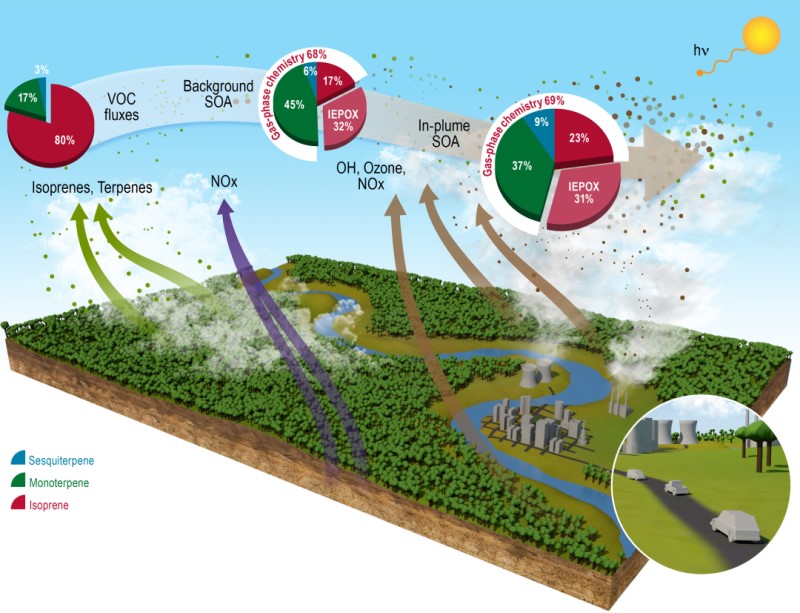When a pristine rainforest encounters a pollution plume
Submitter:
Shrivastava, Manishkumar — Pacific Northwest National Laboratory
Fast, Jerome D — Pacific Northwest National Laboratory
Area of research:
Aerosol Processes
Journal Reference:
Science
What happens in a rainforest when urban pollution interacts with pristine air, making numerous fine atmospheric particles that scatter or absorb sunlight and modify characteristics of clouds and precipitation? Scientists at the U.S. Department of Energy led a study that examined the formation of a class of particles known as biogenic secondary organic aerosols (SOA) in the Amazon rainforest. These particles are formed by the oxidation of gases emitted by plants and trees and constitute a major fraction of naturally produced submicrometer particles over the rainforest. The Amazon transitions between pristine conditions representing preindustrial times and polluted conditions from urban emissions, especially during the wet season. Researchers found that nitrogen oxide (NOx) emissions from Manaus, a Brazilian city of 2 million people within the Amazon rainforest, increased concentration of oxidants (such as ozone and hydroxyl radicals) that, in turn, enhanced biogenic SOA production by up to 400 percent. The increase in biogenic SOA formation within the Amazon was much larger than what has been observed and reported over most locations worldwide.
Impact
Because human activities have already significantly modified the atmosphere over most continental locations in the world, it is difficult to determine baseline undisturbed biogenic SOA levels that would exist in the absence of human influence. The vast Amazon rainforest provides a unique lens to investigate how chemical pathways of SOA formation evolved from preindustrial times to urban-influenced, present-day conditions. Results from this study present a clear picture of how NOx emissions from human activities are likely to have greatly increased biogenic SOA formation over the Earth since preindustrial times. The study implies that in the future, rapid urbanization might substantially increase biogenic SOA formation over pristine forested regions such as the Amazon. This would likely alter Earth’s energy budget and modify cloud formation, atmospheric convection, and precipitation characteristics over those regions.
Summary
One of the least understood aspects of atmospheric chemistry is how urban emissions influence the formation of natural biogenic SOA. These particles arise from oxidation of large amounts of gaseous carbon emitted as volatile organic compounds (VOCs) from sources such as plants and trees. Researchers investigated how emissions from human activities modify different chemical pathways of biogenic SOA formation over the Amazon region. To do this, they simulated SOA formation over the Amazon in a high-resolution regional chemical transport model at a fine grid spacing of 2 kilometers to explicitly resolve features in clouds, emissions, and chemistry. The team integrated insights from laboratory-based measurements, and also field measurements from the Green Ocean Amazon (GoAmazon 2014/15) campaign to develop new SOA chemistry treatments, which they included within the model. They evaluated model predictions of NOx, VOCs, oxidants, and organic aerosols using aircraft measurements from GoAmazon 2014/15. To understand effects of the Manaus urban plume on natural aerosols, the researchers compared changes in biogenic SOA concentrations predicted by two sets of simulations: one in which both forest and urban emissions were turned on, and the other in which forest emissions were on, but urban emissions were turned off.
Aircraft measurements and model predictions both indicated average increases of 60−200 percent in SOA concentrations with a maximum increase of about 400 percent in the Manaus urban plume compared with regions outside the plume. In pristine locations not affected by the urban plume, soil NOx emissions from the forest maintained background oxidant concentrations, but they were an order of magnitude smaller than NOx emitted from the city. The large increase of NOx within the plume increased oxidants that promoted gas-to-particle conversion of VOCs emitted by the forest. This led to increased SOA formation in the plume. The enhancements in biogenic SOA formation over the Amazon were much greater than other reported observations worldwide. For example, a previous study found that over the United States, NOx emissions from human activities were responsible for just a 20 percent increase in biogenic SOA. However, absolute SOA mass concentrations within the Amazon are likely smaller than those in more polluted continental regions like the United States.
The study also showed that even within the Manaus plume, organic aerosol mass formed due to human activities was much lower compared to biogenic SOA. The key effects of human activities were manifested in terms of major shifts in atmospheric chemistry and in oxidants, which promoted the conversion of forest carbon to biogenic SOA. The findings suggest that rapid urbanization in relatively pristine regions of the world such as the Amazon would strongly increase formation of biogenic SOA. This would have substantial implications for Earth’s radiation budget, biosphere-atmosphere feedbacks, and the hydrological cycle.


